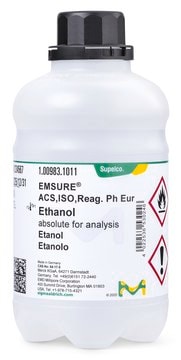1.06007
Methanol
≥99.9% (GC), gradient grade, suitable for HPLC, LiChrosolv®, reag. Ph. Eur.
Synonym(s):
Methyl alcohol
About This Item
Recommended Products
product name
Methanol, gradient grade for liquid chromatography LiChrosolv® Reag. Ph Eur
grade
gradient grade
gradient grade
Quality Level
Agency
reag. Ph. Eur.
vapor density
1.11 (vs air)
vapor pressure
128 hPa ( 20 °C)
410 mmHg ( 50 °C)
97.68 mmHg ( 20 °C)
product line
LiChrosolv®
Assay
≥99.9% (GC)
form
liquid
autoignition temp.
725 °F
potency
5628 mg/kg LD50, oral (Rat)
17100 mg/kg LD50, skin (Rabbit)
expl. lim.
36 %
technique(s)
HPLC: suitable
impurities
≤0.0002 meq/g Acidity
≤0.0002 meq/g Alkalinity
≤0.02% Water
evapn. residue
≤2.0 mg/L
color
APHA: ≤10
transmittance
210 nm, ≥20%
220 nm, ≥60%
230 nm, ≥75%
235 nm, ≥83%
250 nm, ≥95%
260 nm, ≥98%
refractive index
n20/D 1.329 (lit.)
kinematic viscosity
0.54-0.59 cSt(20 °C)
bp
64.7 °C (lit.)
mp
−98 °C (lit.)
transition temp
flash point 9.7 °C
density
0.791 g/mL at 25 °C (lit.)
UV absorption
λ: 225 nm Amax: ≤0.170
format
neat
storage temp.
2-30°C
SMILES string
CO
InChI
1S/CH4O/c1-2/h2H,1H3
InChI key
OKKJLVBELUTLKV-UHFFFAOYSA-N
Looking for similar products? Visit Product Comparison Guide
General description
Application
- In the mobile phase to separate mercury species on a Zorbax C18 reverse phase column.
- To wash the cartridges and as an eluent to extract the analytes during the solid-phase extraction (SPE) process.
Preparation Note
Analysis Note
Identity (IR): conforms
Evaporation residue: ≤ 2.0 mg/l
Water: ≤ 0.02 %
Color: ≤ 10 Hazen
Density (d 20 °C/20 °C): 0.791 - 0.793
Boiling point: 64 - 65 °C
Acidity: ≤ 0.0002 meq/g
Alkalinity: ≤ 0.0002 meq/g
Gradient grade (at 235 nm): ≤ 2.0 mAU
Gradient grade (at 254 nm): ≤ 1.0 mAU
Fluorescence (as quinine at 254 nm): ≤ 1.0 ppb
Fluorescence (as quinine at 365 nm): ≤ 0.5 ppb
Transmission (at 210 nm): ≥ 20 %
Transmission (at 220 nm): ≥ 60 %
Transmission (at 230 nm): ≥ 75 %
Transmission (at 235 nm): ≥ 83 %
Transmission (at 250 nm): ≥ 95 %
Transmission (from 260 nm): ≥ 98 %
Absorbance (at 225 nm): ≤ 0.170
Filtered by 0.2 µm filter.
Suitable for UPLC / UHPLC /Ultra HPLC - instruments.
Conforms to Methanol R1 and R2 according to Reag. Ph Eur;
conforms to the requirements of ACS for liquid chromatography suitability.
Other Notes
Legal Information
related product
Signal Word
Danger
Hazard Statements
Precautionary Statements
Hazard Classifications
Acute Tox. 3 Dermal - Acute Tox. 3 Inhalation - Acute Tox. 3 Oral - Flam. Liq. 2 - STOT SE 1
Target Organs
Eyes,Central nervous system
Storage Class Code
3 - Flammable liquids
WGK
WGK 2
Flash Point(F)
49.5 °F - closed cup
Flash Point(C)
9.7 °C - closed cup
Certificates of Analysis (COA)
Search for Certificates of Analysis (COA) by entering the products Lot/Batch Number. Lot and Batch Numbers can be found on a product’s label following the words ‘Lot’ or ‘Batch’.
Already Own This Product?
Find documentation for the products that you have recently purchased in the Document Library.
Customers Also Viewed
Articles
Apixaban is sold under the tradename Eliquis and at present no pharmacopeial monographs are available for Axpixaban using either an assay and/or organic impurity profiling method. A newly developed and validated HPLC-UV method using a column with C18 solid core particles is demonstrated.
TLC plates, with silica gel, gypsum as binder, International Pharmacopoeia compliant, for identification of Atenolol and Chlorthalidone in tablets
In this study, LC-ESI-MS/MS under reversed phase conditions using a Superspher RP-18 column is applied to analyze dyestuffs of a reddish historic textile from South America.
The most frequently used synthetic sweeteners are: saccharin, cyclamate, aspartame, and sucralose (E955), and this application illustrate the analysis of sucralose from soy sauce following the current Chinese national standard method.
Protocols
Sildenafil Citrate Method (HPLC) following USP Monograph on Ascentis Express C18 with UV detection
Aripiprazole is an atypical antipsychotic and a partial dopamine agonist. It is primarily used in the treatment of schizophrenia, bipolar disorder, major depressive disorder, tic disorders, and irritability associated with autism. Aripiprazole was first approved by the U.S. Food and DrugAdministration in November 2002 for schizophrenia and by the European Medicines Agency in June 2004 for acute manic and mixed episodes associated with bipolar disorder.
The modern thin-layer chromatography (TLC) offers advantages also in the field of cosmetics to quickly and simultaneously analyze samples with densitometric detection.
Powdered black pepper was chosen as example for dietary supplements, being a source for pierine. It is tested according to the current United States Pharmacopeia (USP) guidelines using HPTLC and HPLC.
Our team of scientists has experience in all areas of research including Life Science, Material Science, Chemical Synthesis, Chromatography, Analytical and many others.
Contact Technical Service






